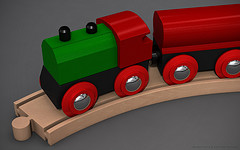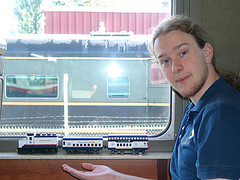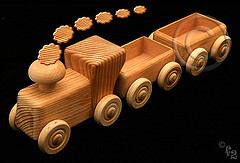 In 1936 Marshal H. Larrabee II founded the Skaneateles Handicrafters, a toy company which made wooden toy trains and wooden tracks. The gauge was very similar to that used by most companies today, and so the rolling stock is compatible. However, the connections for the track pieces were of a different design than the jigsaw style “peg and hole” system used today.Trains were usually left unpainted and unstained, the parts being made of maple. In 1956 Playskool took over the sales for Skaneateles Handicrafters keeping the design style and track connecting system well into the sixties. Marshal H. Larrabee sold his company to the Germany based Habermaaß GmbH in 1980. It was renamed to T.C. Timber and kept producing in Skaneateles until 2002, when the production line was closed down.
In 1936 Marshal H. Larrabee II founded the Skaneateles Handicrafters, a toy company which made wooden toy trains and wooden tracks. The gauge was very similar to that used by most companies today, and so the rolling stock is compatible. However, the connections for the track pieces were of a different design than the jigsaw style “peg and hole” system used today.Trains were usually left unpainted and unstained, the parts being made of maple. In 1956 Playskool took over the sales for Skaneateles Handicrafters keeping the design style and track connecting system well into the sixties. Marshal H. Larrabee sold his company to the Germany based Habermaaß GmbH in 1980. It was renamed to T.C. Timber and kept producing in Skaneateles until 2002, when the production line was closed down.
 During the fifties the Jack-Built Toy Manufacturing Company had an own range of wooden toy trains (ca.1956-62) under their brand name “Jack Built Snap Trains”, that were manufactured in Japan. They were compatible with the products from Skaneateles Handicrafters in size and make except for the coupling system. Although the rolling stock could thus be used on either tracks, neither the tracks or the rolling stock could be combined. Jack-Built used a snap system for both the rolling stock and the tracks. California based Ben Orel filed US patent #2847798 in 1956 and was granted the patent for his “snap coupling” system two years later. In the US patent #3013726[7], submitted by Ben Orel in 1960, he describes how the track could be rotated and thus a “rail” and a “road” side could be used. This is quite similar to what Learning Curve later used for their “Thomas & Friends” range. Already in 1958 Ben Orel submitted a patent for magnetic couplings, this may have been the earliest attempt to use magnets with the wooden toy train system. By the mid sixties though production seems to have stopped and the company disappeared from the toy market.
During the fifties the Jack-Built Toy Manufacturing Company had an own range of wooden toy trains (ca.1956-62) under their brand name “Jack Built Snap Trains”, that were manufactured in Japan. They were compatible with the products from Skaneateles Handicrafters in size and make except for the coupling system. Although the rolling stock could thus be used on either tracks, neither the tracks or the rolling stock could be combined. Jack-Built used a snap system for both the rolling stock and the tracks. California based Ben Orel filed US patent #2847798 in 1956 and was granted the patent for his “snap coupling” system two years later. In the US patent #3013726[7], submitted by Ben Orel in 1960, he describes how the track could be rotated and thus a “rail” and a “road” side could be used. This is quite similar to what Learning Curve later used for their “Thomas & Friends” range. Already in 1958 Ben Orel submitted a patent for magnetic couplings, this may have been the earliest attempt to use magnets with the wooden toy train system. By the mid sixties though production seems to have stopped and the company disappeared from the toy market.
Early Companies in Europe
In 1958, BRIO, based in Osby in southern Sweden, introduced its wooden toy train system with wooden tracks in Europe. It may have been the first company to use the “peg and hole” system, used to connect the track pieces, in mass production. The metal hook system for the rolling stock has since been replaced by magnetic connectors. BRIO was also one of the first companies to use beechwood for such products.
 The “Thomas & Friends” version of James at the The Toy Train Depot in Alamogordo “Thomas the Tank Engine” is a character created by the Rev. W. Awdry in The Railway Series of children’s books. The books were first published in the U.K. in 1945. In 1984 a television series called Thomas the Tank Engine and Friends was made adding to the popularity of the “characters”. It was first shown in the United States in 1989. John W. Lee founded the company “Learning Curve Toys” in 1993 with a wooden railway system called “Thomas & Friends” based on the Thomas the Tank Engine characters. This made the wooden toy trains even more popular than before. Learning Curve introduced some new designs for the track surface, such as the “Clickety Clack” rails patented 1995 and the newer tracks in 2003 with a relief to supply better traction grip for battery powered four wheel drive trains patented in 1998.
The “Thomas & Friends” version of James at the The Toy Train Depot in Alamogordo “Thomas the Tank Engine” is a character created by the Rev. W. Awdry in The Railway Series of children’s books. The books were first published in the U.K. in 1945. In 1984 a television series called Thomas the Tank Engine and Friends was made adding to the popularity of the “characters”. It was first shown in the United States in 1989. John W. Lee founded the company “Learning Curve Toys” in 1993 with a wooden railway system called “Thomas & Friends” based on the Thomas the Tank Engine characters. This made the wooden toy trains even more popular than before. Learning Curve introduced some new designs for the track surface, such as the “Clickety Clack” rails patented 1995 and the newer tracks in 2003 with a relief to supply better traction grip for battery powered four wheel drive trains patented in 1998.